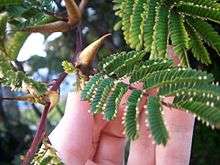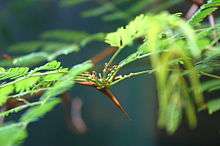Vachellia cornigera
Vachellia cornigera, commonly known as bullhorn acacia (family Fabaceae), is a swollen-thorn tree native to Mexico and Central America. The common name of "bullhorn" refers to the enlarged, hollowed-out, swollen thorns (technically called stipular spines) that occur in pairs at the base of leaves, and resemble the horns of a steer. In Yucatán (one region where the bullhorn acacia thrives) it is called "subín", in Panamá the locals call them "cachito" (little horn). The trees are commonly found in wet lowlands[2]
| Vachellia cornigera | |
|---|---|
 | |
| Scientific classification | |
| Kingdom: | |
| (unranked): | |
| (unranked): | |
| (unranked): | |
| Order: | |
| Family: | |
| Genus: | |
| Species: | V. cornigera |
| Binomial name | |
| Vachellia cornigera (L.) Seigler & Ebinger | |
 | |
| Range of Vachellia cornigera | |
| Synonyms | |
| |
Morphology
Bullhorn acacias are often found as 10 meter (33 ft.) trees. Their bark is gray to brown in color and has small furrows. The new growth of the branches is a reddish brown color and is covered in a pubescence, or a covering of small hairs. The leaves are alternate with a pair of stipular spines where the leaf connects to the branch. The spines can vary widely in color from brown, red, and yellow[3]. The spines are home to ants that protect the plant from herbivory. Beltian bodies can be found at the tips of the leaves. They are full of fats and sugars that feed the ants[2]. The tree also produces carbohydrate-rich nectar from glands on its leaf stalk.This type of relationship is called myrmecophily.
Symbiotic relationship

Bullhorn acacia is best known for its symbiotic relationship with Pseudomyrmex ferruginea, an ant that lives in its hollowed-out thorns. Unlike other acacias, bullhorn acacias are deficient in the bitter alkaloids usually located in the leaves that defend against ravaging insects and animals. Bullhorn acacia ants fulfill that role.
The ants act as a defense mechanism for the tree, protecting it against harmful insects, animals or humans that may come into contact with it. The ants live in the thorns. In return, the tree supplies the ants with Beltian bodies, or protein-lipid nodules, and nectar. These Beltian bodies have no known function other than to provide food for the ants. The aggressive ants release an alarm pheromone and rush out of their thorn "barracks" in great numbers.
According to Daniel Janzen, livestock can apparently smell the pheromone and avoid these acacias day and night.[4] Getting stung in the mouth and tongue is an effective deterrent to browsing on the tender foliage. In addition to protecting V. conigera from leaf-cutting ants and other unwanted herbivores, the ants also clear away invasive seedlings around the base of the tree that might overgrow it and block out vital sunlight.
Uses
Decorative uses
The thorns of V. cornigera, are often strung into unusual necklaces and belts. In El Salvador the horn-shaped thorns provide the legs for small ballerina seed dolls which are worn as decorative pins.
Traditional medicine
The thorns of V. cornigera are also used in traditional Maya acupuncture.[5]
References
- Acacia cornigera (ILDIS LegumeWeb)
- Morse, Clinton. "Vachellia cornigera {Fabaceae} Bull-thorn Acacia". florawww.eeb.uconn.edu. Retrieved 2020-04-24.
- "Factsheet - cornigera". www.anbg.gov.au. Retrieved 2020-04-24.
- Daniel Janzen, Costa Rican Natural History, 1983
- Saqui, Aurora Garcia (2016). Ix Hmen U Tzaco Ah Maya: Maya Herbal Medicine. Caye Caulker, Belize: Produccicones de la Hamaca. p. 42. ISBN 9768142863.
External links
| Wikimedia Commons has media related to Vachellia cornigera. |
| Wikispecies has information related to Vachellia cornigera |
- Vegetation of Belize
- Community Ecology
- Backyard Nature
- Leichty, Aaron R.; Poethig, R. Scott (2019). "Development and evolution of age-dependent defenses in ant-acacias". Proc Natl Acad Sci U S A. 116 (31): 15596–601. doi:10.1073/pnas.1900644116. PMC 6681755. PMID 31308222.